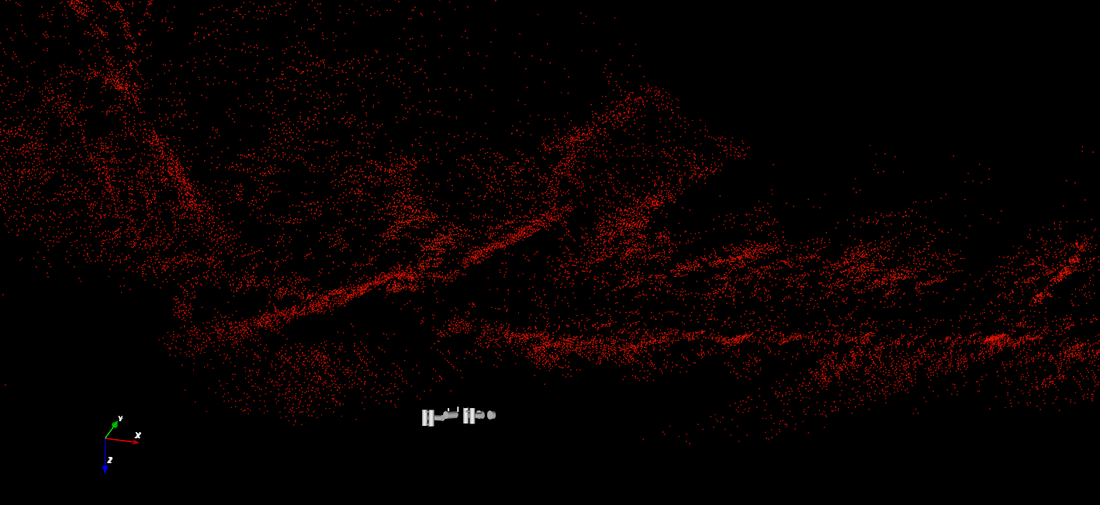Our Biggest Day Yet
After Fleet Ops and the Antarctic Support Divers kindly rescued ARTEMIS during our previous sea ice mission run without a robot safety line, we had some long and difficult discussions about the conditions leading up to the need for rescue. Much discussion focused on an effect we had anticipated long ago, but had perhaps not placed enough importance on: the forces on the robot when a large amount of data fiber is payed out in the water. Even though the data fiber is incredibly thin, over kilometers of line currents can build up significant forces, yanking the robot this way and that, and even threatening to snap the fiber completely. ARTEMIS spools fiber out of its tail to try to isolate some of these forces, but the system is not perfect. Additionally, the robot experiences a change in buoyancy and trim as more fiber is spooled out – the fiber is designed to sink to keep it away from gnarly ice “stalactites” we feared could tangle it on the ice ceiling during proximity operations, but this means that ARTEMIS tends to nose down and float upwards as fiber is removed (since the spool is at the rear). Hints of these effects had manifested themselves in our control instabilities during the previous sea ice mission (whose “fix” led to our need for rescue), but the tricky bit is that these effects had stayed minimal up to this point because all our missions using a safety line were confined to a relatively short 1km radius of the borehole (the length of the safety line). During a true 5 km mission, these effects could be much worse, but there was no present way to know how much worse without ditching the safety line and trying it.
So we debated the dangers long and hard, but we decided the science was too valuable to not try – ARTEMIS would dive again off tether. Science is about exploring the unknown, and the unknown is risky. This is what ARTEMIS was made for.
We decided to repeat the previous failed sea ice mission because we had already proven it was possible to rescue ARTEMIS under sea ice if it became disabled or lost, whereas under the ice shelf we had a larger chance of losing the robot permanently (the ice is too thick to drill). We set ARTEMIS out on the same track as last time. The objectives: Transect 5 km north of the borehole under sea ice at a ceiling standoff of 7 meters. Gather PAR (Photosynthetically Active Radiation), sonar maps, and other biological and oceanographic data along the way. At the 1 and 3 km marks, pause and rise to the ice ceiling so that the surface team could localize ARTEMIS using the magnetic beacon and ensure navigational accuracy with a GPS fix. At 3.3 km, approach closer to the ceiling and slow down to image the underside of Big John crack at high resolution using the sonars and the up-look camera. At the 5km mark, dive to 40m depth and perform a vertical upcast to the ceiling while taking water samples for later scientific analysis. At any point, if problems arose satisfying our mission abort criteria, we would turn around and come home immediately. We had Fleet Ops and the divers on standby in case another rescue operation was needed.

ARTEMIS creates a 3D sonar point cloud map underneath Big John Crack
The journey outbound went extremely smoothly, and we had a slight tail current to the NE, so we moved along quite quickly, and our battery reserves were high. We stayed as close as we safely could to the ice ceiling to gather PAR data. Our navigation performed admirably – each time we stopped to localize using the magnetic beacon, the surface team confirmed that our navigation error was less than 0.1%. On the way out, we missed Big John Crack because it looked underwhelming (the platelet ice had filled it in from below), so we drove past it thinking it was a smaller, less interesting crack. On the way back we did a good job of imaging it with our cameras and mapping it at high resolution with our sonars. We are very excited to analyze all the data in more detail.
Once we turned around, many of our fears about the fiber forces were confirmed. The robot started having control difficulties, so I took over driving manually with the joystick (an Xbox controller) as a precaution. At about 3km from home, things started getting really difficult to control because of fiber forces and buoyancy changes. The fiber tension on the surface was getting tighter and tighter, so we knew that the current/drag forces had gotten large enough that ARTEMIS was still spooling fiber during the return leg, instead of pulling back the fiber payed out on the outbound leg. We also knew that it was only a matter of time until this force became strong enough to snap the fiber. Next time, we should have fiber spoolers on both the surface and the robot. Finally, although it was fighting me the whole way, I was able to bring the robot back home and dock it to the docking bar, and we pulled it up the borehole with a great collective sigh of relief. No rescue needed this time. It was definitely the most stressful video game I have ever played… We cut the fiber on the robot side because it had too much tension to recover it, and a few minutes later, the surface side snapped of its own accord. Post-mission analysis showed that we had spooled out 12.6km kilometers for our 5km out-and-back run.
But we did the science we wanted, and we got the robot back. Definitely a success.
Reporting by Evan Clark